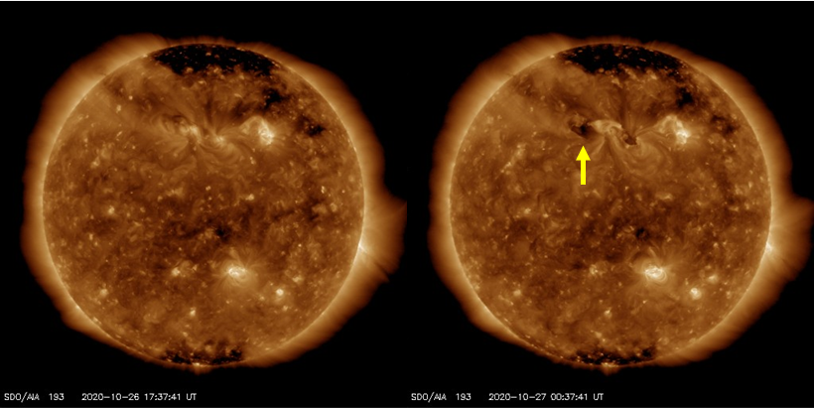Sunspot region NOAA 2778 developed quickly on 25 October into a relatively large group. As it further matured, it got the company of a small and short-lived sunspot region to its southwest (lower right) on 26 and 27 October. This region remained unnumbered. Then, shortly after noon on 28 October, a larger region emerged to the northeast (upper left) of NOAA 2778. NOAA 2779 showed some complex sunspot structures, but remained smaller than its big brother. The clip underneath shows the evolution of this area from 25 till 30 October in white light as seen by SDO / HMI.

The subtle changes in the sunspot and group development can also be followed by hovering over the regions. This can be done using the tracking feature of the JHelioviewer tool. They eye does not have to compensate for the rotation of the Sun, and so can focus better on the actual changes in the sunspot groups.

Both groups showed some mixing of magnetic polarities resulting in a number of small solar flares. NOAA 2778 produced 5 C-class flares on 27 and early on 28 October, the strongest being a C4.3. Then, late on 28 and on 29 October, the still growing active region NOAA 2779 took over and produced 7 C-class flares, the strongest being a C4.3 peaking near noon on 29 October. The imagery underneath shows the regions in white light (left) and in extreme ultraviolet (EUV, SDO/AIA 131), with the graph showing the x-ray flux. "-6" means to 10-6 Watts per square meter, corresponding to the C1 flaring level. The images show the two strongest flares (C4.3) respectively on 27 and 29 October.

No obvious coronal mass ejections (CMEs) were associated with these flaring events. A CME with an earth-directed component was observed on 26-27 October and originated from the same source responsible for the 23 October CME as described in this STCE Newsitem The annotated EUV image shows the location of the coronal dimming, a tell-tale sign that material got ejected by the eruption. Apparently, the first eruption did not destroy (entirely) the magnetic topology of the filament channel, allowing for a "Oops!...I Did It Again" moment 3 days later. The weak interplanetary CME arrived at the earth environment near noon on 1 November, and created only unsettled to active geomagnetic conditions.






